Borthwick Newsletter - August 2023
Posted on 31 July 2023
August in the Archives - delve into our catalogues with this month’s featured description.
Correspondence between N.A.S. Lytton-Milbanke and Seebohm Rowntree concerning the social insurance schemes expected by Rowntree after the war and his ideas on mitigating effects on young people of monotonous work of "conveyor belt operations", 20 August 1942 - 25 August 1942. [Rowntree Family Papers, RFAM/BSR/JRF/8/10/7]
What’s New?
We’ve been in a celebratory mood this past month as we marked the Borthwick’s 70th birthday with a visit from the Archbishop of York, a very large cake and the publication of a book of poetry by our first Director, Canon John Stanley Purvis. In the seventy years since the Borthwick was founded we’ve taken in more than 700 archival collections spanning over 900 years, but our history began with the dream of a university in York and the work of Canon Purvis, Archivist to the Archbishop. When he took up his post at the newly created Institute in 1953 he brought the vast diocesan archive with him and our Anglican church collections - from the records of the Archbishops down to those of parish church and priest, are still among our most popular collections.
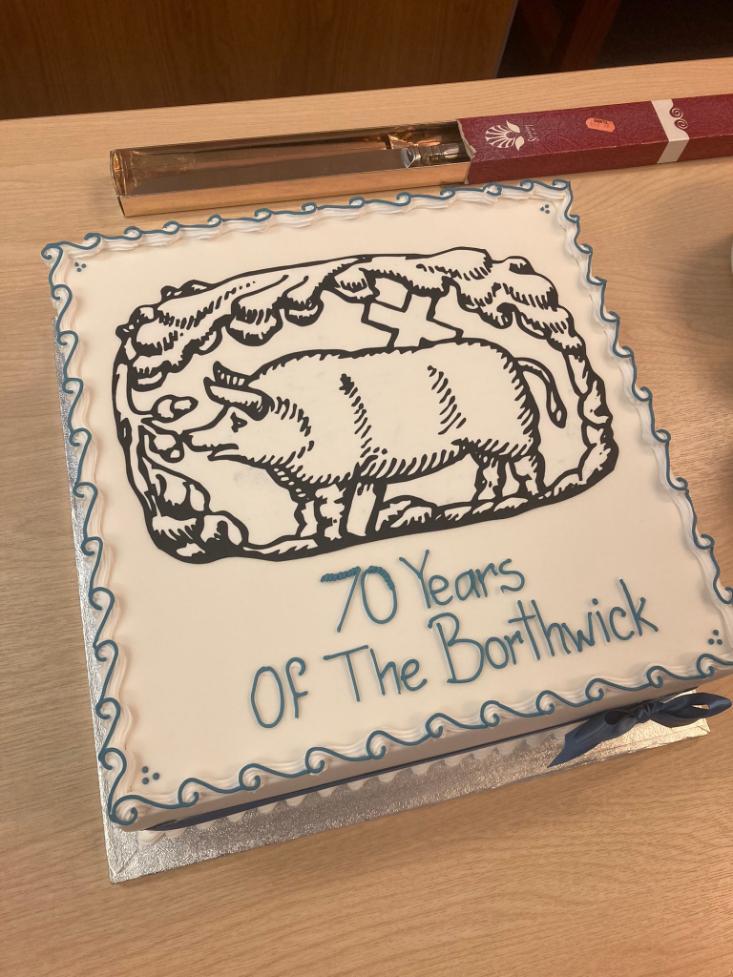
We have, of course, expanded our holdings significantly in the decades since, and the Archbishop, along with staff, volunteers, and guests, were treated to a display of archives past and present in the searchroom, which ranged from the 13th century register of Archbishop Walter de Grey to 19th century hospital case books, sketches for adverts for Rowntree’s chocolate, records of the Women’s Land Army in the North Riding of Yorkshire, and scripts belonging to comedian Frankie Howerd. The event also marked the launch of a book of poetry written by Canon Purvis before and during World War One. Two of the poems, ‘Chance Memory’ and ‘High Wood’, were published in his lifetime under the pseudonym Philip Johnstone and have been widely praised. It was only after Purvis’ death, however, that his sister Hilda revealed Johnstone’s true identity, and this is the first time that a collection of Purvis’ poems, many of which have been seen outside of the archive, has appeared in print. The poems have been transcribed and edited by Professor Sue Mendus and you can read more about the collection on the University of York website.
New Accessions
In July Project Archivist Lydia Dean oversaw the transfer of the substantial archive of the Company of Merchant Adventurers of the City of York from the mediaeval hall on Fossgate into the Borthwick’s strongrooms. There were some 280 boxes in all, of varying shapes and sizes, and Lydia will be working for the next few months on updating the existing catalogue, repackaging records where necessary, and making the complete collection searchable on Borthcat.
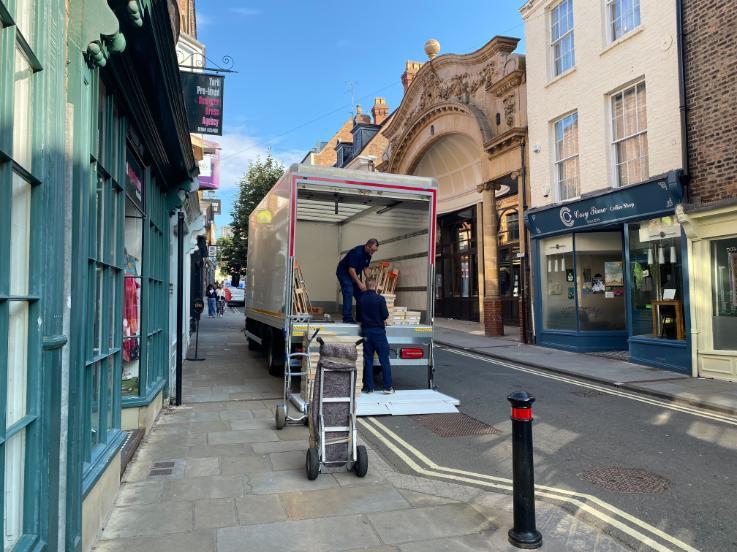
We also added several more deposits to the University of York archive, most notably the archive of Wentworth Graduate College. The college was founded in 1972 and named after Thomas Wentworth, 1st Earl of Stafford and MP for Yorkshire in the 17th century. The archive dates from the college’s founding year and includes comprehensive records for the Staff Common Room Committee, College Council records, and ephemera relating to staff and student life at Wentworth, as well as some website materials from the 1990s which will be ingested into our Digital Archive.
Finally we’ve received another two additions to our York Covid-19 Archive in the form of poetry written during the Pandemic. The poems will be added to the existing catalogue, which you can view on Borthcat, along with digital copies of other documents and photographs from the collection.
Cataloguing
Number of archival descriptions on Borthcat on 1st August 2023: 126,882
In the past month we’ve added the full catalogues of another two of our parish archives: Stamford Bridge and Ledsham, as well as the large catalogue of the Joseph Rowntree Reform Trust Archive. The JRRT archive comprises 388 boxes and more than 2500 archival descriptions covering the work of the Trust from its foundation in 1904 through to 2010s. We are very fortunate to have such a full record of the Trust’s activities, including as it does detailed information about their important work in the fields of politics, human rights, and social justice. You can read about the history of the JRRT on Borthcat, or browse the full catalogue. The ‘Grants and Projects’ series contains all of the surviving grant files, including early funding to organisations like Amnesty International, Friends of the Earth, the Low Pay Unit, and Liberty. There are substantial series of files for the Trust’s work in Northern Ireland and Southern Africa, as well their many decades of support for the Liberal Party and Liberal Democrats. The Trust’s work was funded initially by shares in the Rowntree confectionery company, and then later by investments in newspapers and publishing, television and radio, and property, with the records of their investment in The New Statesman and Society in particular covering a turbulent period in the magazine’s history. As well as general administrative and financial records, the archive includes the records of various Trust Directors, including Richard Rowntree, and Liberal MPs Jo Grimond and Richard Wainwright. It is a unique and enormously rich resource and we are very excited to be able to make it available for research.
Lastly if you’ve been following us on social media you may have seen a mention of another improvement to our online offerings in the form of fully digitised copies of the first four Visitation Court Books for the Archdeaconry of York, covering 1598, 1613, 1664-1680, and 1681-1690. Visitations acted as a kind of inspection of a parish, or number of parishes, in particular of the moral and religious behaviour of its inhabitants - whether they were attending church, accusations of sinful or immoral actions for example - as well as settling local disputes. As such they form a rich (and sometimes scandalous) source of information about the religious and social lives of clergy and parishioners. The first four books are arranged by rural deanery, covering York City, Old and New Ainsty, Craven, Doncaster and Pontefract) and they are available to read for free via JSTOR. Why not have a look - and let us know if you find anything particularly exciting!
Borthwick Out and About
There’s been lots going on at the Borthwick and beyond in July. In addition to our 70th birthday celebrations, we took part in the university’s Open Days, introducing prospective students to a range of archives, many of which are used in teaching and research, as well as the annual Staff Festival, with Keeper of Archives Gary Brannan taking staff on a tour of our comedy archives.
Elsewhere the publication of Canon Purvis’ war poems was featured in the York Press and several of our records, including one of our most fascinating wills - that of Starkie Jennings of Haworth in 1833 - was featured in a new blog on ‘Accessibility and Archives: Combining Archaeology and the Archival Record’, published by the Archives and Records Association of the UK and Ireland.
Speaking of wills, we were very excited to discover an unusual joint will in one of our early probate registers. The will of Anthony Atkinson ‘& Margarett his wife’ was made in 1669 and we featured it on our Twitter account in the hope of finding out more, as it was the first joint will any of our staff had come across. Thanks to the helpful replies we now know that the National Records of Scotland also hold some joint testaments from the 16th century and that we ourselves have two wills made on the same day in 1390 in one of our Archbishops Registers. In that case the husband and wife were taking precautions before they set off on a pilgrimage!
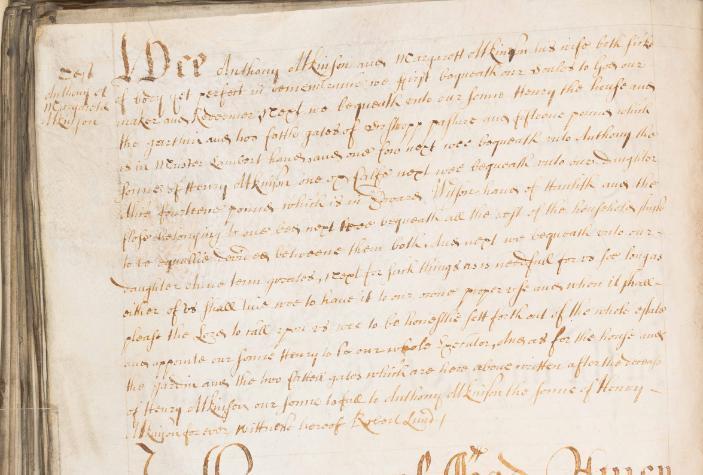
We’ve also been sharing our collections at external events. University Art Curator Helena Cox spoke about the importance of university collections and their use in teaching, research and public engagement for the ‘Imaginations’ series by the International Council of Museums (ICOM), whilst Access and Engagement Archivist Laura Yeoman and Collections Information Archivist Sally-Anne Shearn represented the Borthwick at the History Day Fair at the DCDC Conference in Durham, armed with our banner and trusty leaflets. The annual conference attracts people from all across the heritage sector and it was great to meet people from all over the UK and chat about our collections and what we do.
Archive of the Month: Records of Munby and Scott, solicitors of York
What is it? The records of a legal firm in York which became Munby & Scott in 1878 when Henry Venn Scott joined as a partner, although the Munby family had been practising law in York since at least the eighteenth century. In 2008 the firm merged with Langleys.
Where can I find it? There is a fonds level description available online and the collection has been box listed.
Why is it Archive of the Month? The contents of a solicitors’ archive can be something of a treasure trove. The law relies on careful record keeping and legal firms might well keep deeds and documents for centuries until, with any luck, they end up in a local record office.
This is exactly what happened with Munby & Scott. As well as legal and financial papers relating to the Munby and Scott families themselves, the archive contains records for property and organisations in York dating all the way back to the 1660s. One of the most exciting discoveries was a bundle of deeds and documents relating to York Castle and Clifford’s Tower, tracing the story of its ownership from the reign of James I to the 1930s, as the city grew and changed around it. Some of the later documents concern the laying of tramways around the site and the installation of a telephone to the Assize Court which now forms part of York Castle Museum.
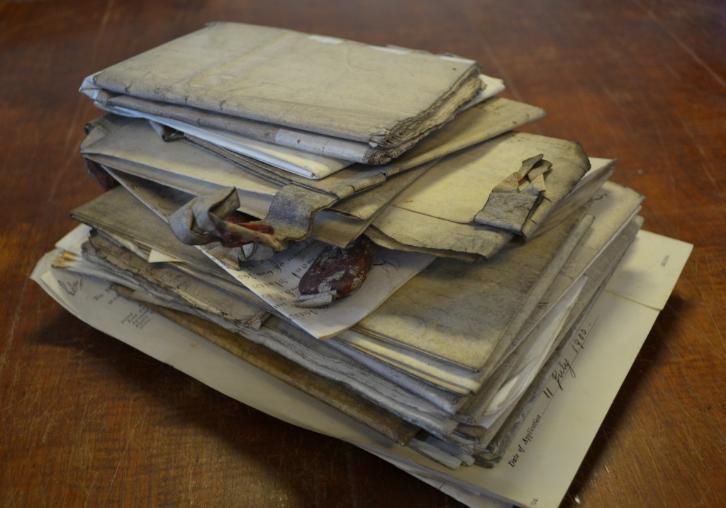
The archive also contains records relating to local schools. The firm acted at various times for Yorkshire School for the Blind, Manor School, the York Industrial Ragged School, the York Church of England National School Society and Archbishop Holgate’s Grammar School. Along with the legal papers and correspondence you might expect, the firm also holds the minute books of the York Industrial Ragged School, 1857-1862, the Ragged Schools Female Committee, 1849-1863, the Manor School, York, 1881-1903, and the York Church of England National School Society, 1895-1923.
Intriguingly, the records of the Ragged School cover a period of history that has become famous on the various Ghost Walks of York. In the mid 19th century, or so the story goes, the York Industrial Ragged School was opened for the poor and run by parish Beadle, George Pimm, who was paid for each child he placed in the school. Conditions were so harsh that many children died and, rather than report their deaths and lose his source of money, Pimm was said to have hidden their bodies around the site and was subsequently driven to madness by their ghosts. The surviving minute books cover 1849 (the year after the school opened) to 1863 and are rather more mundane than the legend suggests, with no mention of any scandal at the school, or indeed of Pimm. In fact the school has such a lot of trustees, officers and committees, that it’s hard to imagine any one person being able to hide so many deaths without being caught - bad news for the ghost walks perhaps, but better news for the children!
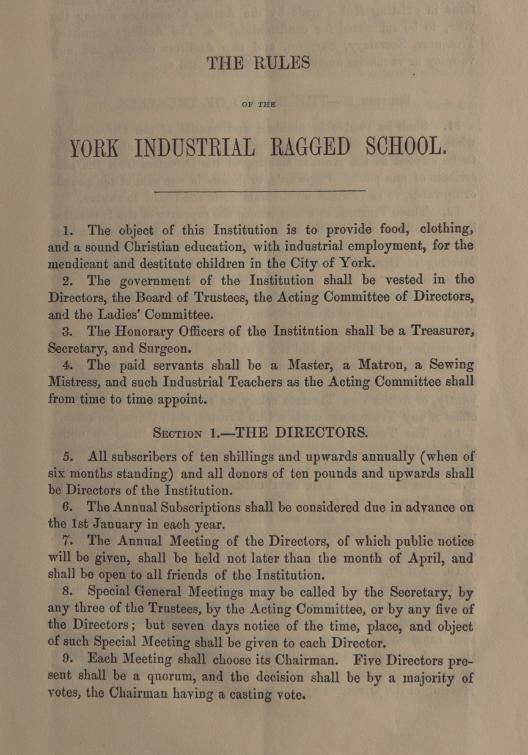
These minute books represent just a few of the fascinating survivals, and are a good reminder that records do not always turn up in the collections you expect. With its mix of legal, financial, and institutional records, the archive of Munby and Scott allows us to fill in a few more gaps in our knowledge of York, its institutions, its people and its places over the past four centuries.
We'll be back in September with more news from the archives!

